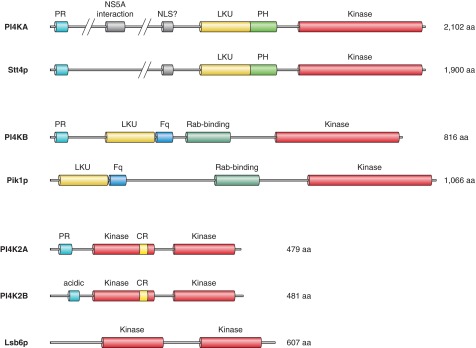Figure 3.

The family of PI 4-kinase enzymes. PI 4-kinases (PI4Ks) have two major types, the type III and type II enzymes [the type I enzyme(s) turned out to be the PI 3-kinases]. The type III enzymes are comprised of two proteins: the larger (∼210–230 kDa) PI4KA (Stt4p in yeast) and the smaller (∼92–110 kDa) PI4KB (Pik1p in yeast). These enzymes are relatives of PI 3-kinases and the PIK-related protein kinases, with a highly conserved COOH-terminal catalytic domain. They also have lipid-kinase unique (LKU) domains also found in PI 3-kinases. Other domains include proline-rich sequences (PR) and a frequennin-binding (Fq) domain in the PI4KB form. The smaller sized (∼56 kDa) type II PI4Ks exist in two forms in vertebrates: PI4K2A and PI4K2B that are highly homologous except at their very NH2 termini. [Only one form is found in S. cerevisiae (Lsb6) and in D. melanogaster]. The signature feature of these enzymes is a cysteine-rich (CR) sequence that is palmitoylated in the vertebrate enzymes providing stronger membrane association.
